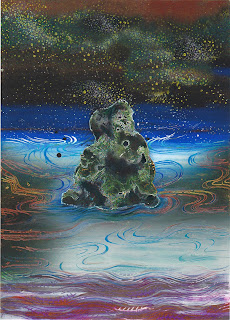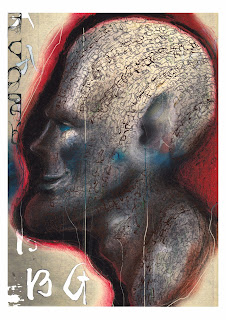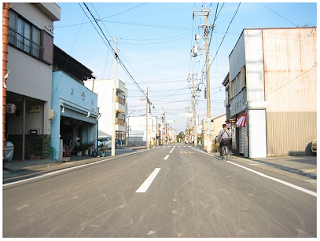Higanbana flowers grow in large clumps around rivers and rice paddies. It's amazing to see them all in full bloom. However, they are in fact poisonous. In this painting I wanted to depict a woman that is sensitive and delicate like the flower but also powerful as represented by the red colour.
2015年10月19日月曜日
Higanbana 03
Higanbana flowers grow in large clumps around rivers and rice paddies. It's amazing to see them all in full bloom. However, they are in fact poisonous. In this painting I wanted to depict a woman that is sensitive and delicate like the flower but also powerful as represented by the red colour.
2015年10月12日月曜日
Higanbana 02
In this piece I designed a necklace and bracelet from the Higanbana motive in my previous pieces under the same theme. The bracelet uses a tradition golden laquer pattern. The necklace uses a pattern inspired by a "dragonfly ball" or traditional Japanese glass marble. The red pattern in the ball is inspired from coral.
2015年10月5日月曜日
Higanbana 01
During the Higan holiday in Japan, it is common to give botamochi, a Japanese sweet using Azuki beans, as an offering to ones ancestors. However, in recent years, people tend to give more varied offerings including what the deceased used to like eating or drinking. In this picture, I drew a bottle of sake as an offering with the Higan flower motive on it.
In Japan, the Autumn equinox is referred to by Buddhists as Higan. Higan is a flower but also in Buddhism it symbolises "the other side" which is a metaphor for leaving the world of confusion and desire behind and crossing over to the other side of enlightenment. It is also a metaphor for the afterlife. During Higan, people pay their respects to their ancestors by leaving botamochi, a kind of Japanese sweet made from red bean paste. This is to nourish one's ancestors in the afterlife.
2015年9月7日月曜日
Hozuki 03
This design uses the 2nd Hozuki painting as inspiration in the kimono belt design. If you look closely, you can see the image of a Hozuki plant, representative of summer in Japan.
2015年8月31日月曜日
Hozuki 02
This design was developed from the first Hozuki picture I created. I wanted to show the passion and heat of summer as well as coolness.
2015年8月24日月曜日
Hozuki 01
This picture expresses my memories of summer. It mixes an image of a fireball and a hozuki plant. In Japanese ghost stories "fireballs" are symbolic of the spirits of ghosts. This is the first in a series of three pictures.
Hozuki plants flower in the summer in Japan. They are used as offerings and decorations for small Buddhist shrines in the home dedicated to one's ancestors. During the Obon season in the summer in Japan, the spirits of one's ancestors are said to return to the family home.
2015年8月3日月曜日
Somen #3
Using the first two paintings in this series, I created this design for a long dress. I tried to make this feel passionate using the black, red and gold colours. This style might be good for modern urban fashion.
Please have a look at the first two paintings in this somen series
Painting #1
Painting #2
Please have a look at the first two paintings in this somen series
Painting #1
Painting #2
2015年7月27日月曜日
Somen #2
This painting uses the first Japanese character of somen - "so" そ. I added colours and some fine brush marks to turn it into a symbol. I'm thinking of using the same technique to paint letters of the alphabet. Please have a look at the first painting in this series here.
2015年7月20日月曜日
Somen #1
My painting
With a single brush stroke I wanted to express the cool feeling of somen noodles. To paint this single brushstroke, I couldn't lift the brush from the paper at all. I had to hold my breath and paint steadily and it took a lot of concentration.
Somen
For Japanese, somen noodles are a representative summer food. They're a great light dish to eat when you feel lethargic and lose your apetitte during the long, hot Japanese summers. For extra nutrition, it's common to eat somen with various topings. Depending on the household, restaurant or region, these toppings include sliced onion, cucumber, stewed meat and various other vegetables which all add to the cool taste.
Click here to find out more about Japanese Somen noodles
With a single brush stroke I wanted to express the cool feeling of somen noodles. To paint this single brushstroke, I couldn't lift the brush from the paper at all. I had to hold my breath and paint steadily and it took a lot of concentration.
Somen
For Japanese, somen noodles are a representative summer food. They're a great light dish to eat when you feel lethargic and lose your apetitte during the long, hot Japanese summers. For extra nutrition, it's common to eat somen with various topings. Depending on the household, restaurant or region, these toppings include sliced onion, cucumber, stewed meat and various other vegetables which all add to the cool taste.
Click here to find out more about Japanese Somen noodles
2015年7月13日月曜日
Tanabata #3
For this picture I used the first two paintings in my Tanabata series as the design for these clothes. This picture depicts the Tanabata story where the woman "Orihime" prays to her lover "Hikoboshi" or Altair that one day they can meet again.
Please have a look at the other painting in this series:
Tanabata #2
Tanabata #1
2015年7月6日月曜日
Tanabata #2
This picture is inspired by "Tanzaku", a strip of paper that you write your wishes on and tie to bamboo leaves during the Tanabata festival held in Japan on 7th July.
2015年6月29日月曜日
Tanabata #1
In this picture I drew the Milky Way over the sea. In Japan, you can often see large rocks rising up from the sea which have a mysterious energy to them.
Check out this link to find out more about the Tanabata festival
What is Tanabata?
This is a festival held in Japan in July. During the festival, people write their wishes on small strips of paper tied to bamboo leaves which decorate shops and houses. On the 7th July, the romantic Tanabata legend tells of the lovers Orihime and Hikoboshi who can only meet for one day in the year as the Milky Way comes into clearer view.Check out this link to find out more about the Tanabata festival
2015年6月22日月曜日
Miminashi Hoichi #3
This picture was developed from my previous work "Miminashi Hoichi #2". This piece is designed in a way that it can be used as fashion.
2015年6月15日月曜日
Miminashi Hoichi #2
This is a picture I developed from the first in the series of drawings entitled Miminashi Hoichi. In the first picture I draw a face covered in Kanji characters. In this picture, I took the kanji script and changed it to roman alphabet but kept the same brsh stroke kanji style.
2015年6月8日月曜日
Miminashi Hoichi #1
This picture entitled "Miminashi Hoichi 1" was inspired from one of the scenes from the play "Miminashi Hoichi". In Japanese ghost stories, ghosts don't attack the living but haunt them for a long time making their lives miserable.
"Miminashi Hoichi" is a ghost story set in the Amidato temple in Shimonoseki city in Yamaguchi prefecture. This type of ghost story is called "Kaidan" in Japanese. The Greek Author Koizumi Yakumo (his Japanese name) turned this traditional story into a short story.
You can read more about the story of Miminashi Hoichi here.
2015年6月1日月曜日
Japanese Art: Wheel Tracks #3
This picture shows a "tenugui" or headscalf or handtowel with a pattern developed from my previous wheel track painting. These tenugui were traditionally used to wipe the hands and face dry. These are worn in festivals and recently have become popular as souvenir gifts with various patterns printed on them.
Tenugui photo - Here is an example of how tenugui are used in traditional festival dances. Click the link to see the works of Keisuke Serizawa, a skilled pattern designer and cloth dyer.
2015年5月25日月曜日
2015年5月18日月曜日
Japanese Art: Wheel Tracks #1
 |
| Japanese modern art "Wheel tracks" |
At the end of a Japanese festival, you can see the remaining wheel tracks of the ceremonial floats on the ground. This inspired this piece where you can see the wheel tracks in the ground that represent the fun and excitement of the festival long after it has ended and the town has fallen silent. Like a typhoon, it is the calm after the storm.
Wheel tracks on the road after a festival in Japan
In Japan, there are many festivals. Each festival has it's own main theme and events. In the case of the Autumn festival in Kakegawa in Shizuoka prefecture, street stalls are one of the main attractions. Local people visit the stalls from mid-day into the night. Also, people pray for a good harvest during the festival, a custom that has continued since the Edo period.
2015年5月11日月曜日
Japanese Art: Taimatsu #3
 |
| Taimatsu 3 |
Links:
Taimatsu #2
Taimatsu #1
2015年5月4日月曜日
Japanese Art: Taimatsu #2
 |
| Taimatsu 2 |
2015年4月27日月曜日
Japanese Art: Taimatsu #1
 |
| Taimatsu 01 |
The inspiration for this picture
Obon is an event held in the summer in Japan where Japanese people pray to their ancestors. Obon usually lasts a week and the spirits of the ancestors are said to return home during this time. Each town and area has it's own unique way of celebrating Obon which includes visiting ancestoral graves and decorating the Buddhist family shrine.
Another custom is to prepare the Mukaebi, a bonfire to welcome the spirits at the beginning of the festival. At the end of Obon is the Okuribi, another ceremonial bonfire is lit to send off the spirits on the last night of Obon.
Each household lights a lantern called a Taimatsu and burn incense to help the spirits not get lost when visiting and leaving the family home.
The Taimatsu is what inspired this painting.
 |
| "Okuribi" flame to send off the ancestral spirits |
2015年4月20日月曜日
Japanese Art: Takoyaki #3
This is the 3rd in the series of 3 pieces inspired by Takoyaki. This picture was developed from the last 2 pieces. The woman is holding the Takoyaki design from the 1st picture and in her hair is a "Kanzashi" from the 2nd piece.
You can see the other pieces here:
Takoyaki #1
Takoyaki #2
You can see the other pieces here:
Takoyaki #1
Takoyaki #2
2015年4月13日月曜日
Japanese Art: Takoyaki #2
This the 2nd in a series of pieces and was developed from the previous Takoyaki #01. The main mediums I used here were water colors and pencil. I then added the "Kanzashi" (a traditional Japanese style hair ornament) using software.
Compared to the first piece, this has a more fashionable feel to it.
Compared to the first piece, this has a more fashionable feel to it.
2015年4月6日月曜日
Japanese Art: Takoyaki #1
 | ||
| Takoyaki #1 |
Takoyaki#1
This is the first of three art pieces I created related to the theme of Takoyaki. In my art, I mostly deal with subjects related to Japanese tradition and culture. In this picture you can see the shape of the Takoyaki which I added some traditional Japanese patterns and colours to.About Takoyaki and Japanese summer festivals
During the summer and autumn months, there are many festivals are held throughout Japan. In each region these festivals are centered around local Shinto shrines where Kami or gods are worshiped.
In and around the Shrine grounds are a lot of stalls selling various popular cooked festival foods including Takoyaki, Yakisoba and Okonomiyaki to name a few. Festival goes love to eat these foods while wondering around and enjoying the various events going on.
The photo above is of a takoyaki stand and was taken at the Yagumo Hikawa Shrine festival which was held last year on September 20th-21th 2014 in Tokyo.
2015年3月30日月曜日
Welcome to my Japan Art Blog
Konnichi wa and welcome to my Japan Art Blog. My name is "The Gonk" and I am a Japanese artist living in Tokyo Japan.
I use this blog to post all of my latest artwork which includes a range of media including oil, water color, charcoal and pencil drawings. I also use digital art software to manipulate and arrange my pieces to give them a modern abstract style.
The main subjects I like to create art about are related to Japanese culture, traditions and art however I like to give it a modern spin through my own interpretation.
If you have any questions about Japan, my art or anything else, please feel free to contact me or leave a comment on the site.
登録:
コメント (Atom)


























